PROCESS OF DELIVERY AND RECEPTION
1. Packaging Regulations
General packaging guidelines for Ninja Van include, but are not limited to:
- Outer packaging: All parcels must have outer packaging covering 100% of the contact area (e.g., carton box or polymer).Otherwise, please wrap it with shrink wrap or bubble wrap the entire package.
- Inner packaging: The inner packaging must be tightly and snugly packed. If not, please fill in the gaps with cushioning material.
- Wrap ceramics, glass, and other fragile items in a protective material such as bubble wrap before placing them in the outer box.
- Bulky goods: Place bulky goods inside a large box and fill the gaps in between with cushioning material.
- Packages must be able to withstand the physical impact of transportation. For sensitive external items such as gift boxes, medicine boxes, cosmetic boxes, paper-wrapped cakes, candies, etc., ensure they are wrapped with shrink wrap or bubble wrap before placing them in the box.
- All fragile items must be labelled as fragile.
- Ensure that there are no previous addresses or old tracking labels on the outer or top of the packaging.
- The package must be labelled with the correct Tracking ID, and the order must be uploaded to the Ninja Van system. Each parcel can only have one unique Tracking ID.
- Each tracking ID corresponds to the package only, and the products are not separable.
- In case multiple shipments (package) are found with the same Tracking ID, the rider should instruct the seller to repack them into one fixed shipment before accepting it.
- Ensure that all electronic devices are powered off and remove batteries if possible.
- When sending liquids or other bottled items, please place them in an upright position and label the package with a vertical label.
- In case, the products, which include box containers from the manufacturer, needed to be protected. Let wrapped in foam on all 6 sides and then securely taped and placed in a sturdy carton box.
| Type | Packaging Method | Illustration Image |
| Cosmetic | A. Each product needs to have its bottle tightly sealed with tape/food wrap, then wrap two layers of bubble wrap around the product to secure the product lid. B. In the case of multiple bottles in one order, they must be separated by air cushioning or elastic materials inserted tightly between the gaps to prevent the products from shifting and colliding during transportation, such as air cushioning, foam, foam peanuts. C. In the case of products inside manufacturer boxes/cases: Wrap the manufacturer's box/case with 3-5 layers of bubble wrap and secure the bubble wrap with tape. D. In the case of products inside plastic trays/shrink wrap: Require foam padding on both the bottom and top, then place them in a separate carton box. E. There should be warning labels for liquid items (labels facing upwards) or fragile items. | 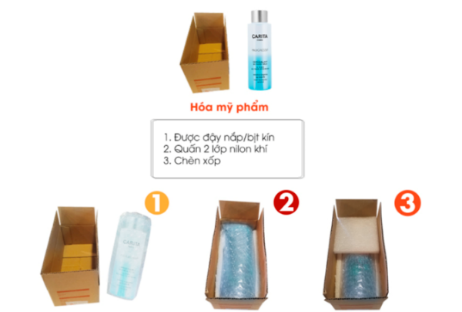 |
| Clothing, shoes, bags | A. For orders without hard carton boxes, simply wrap the package with plastic film and seal it with tape; B. For orders without sturdy carton boxes, additional bubble wrap should be used before wrapping it with plastic film and sealing it with tape; C. In the case of having manufacturer boxes, simply wrap them with regular plastic bags and use tape to securely package the items. D. If the product is without the box containers of the manufacturer, additional bubble wrap should be used before placing them in regular plastic bags and sealing them with tape. E. Clothing, shoes and bags should be folded before packaging, wrapped in 2-3 layers of nylon or shrink wrap, and fully secured with adhesive tape to mitigate risks in case of adverse weather conditions. F. Footwear, slippers and handbags must have an external carton box after being wrapped in 2-3 layers of nylon. In case it is necessary to preserve the original manufacturer box, it should be surrounded by foam padding on all sides, fully secured with tape, and placed in a sturdy carton box. |  |
| Books, paper and office supplies | A. For books and easily absorbent items, it is necessary to pack so that it is waterproof. Wrap them with a layer of bubble wrap on the outside, paying special attention to protecting the corners from bending, and place them in a suitably sized carton box. B. For thin stationery such as maps, stickers, and pictures, they should be rolled up, wrapped tightly in plastic, and placed inside rigid plastic or PE tubes, sealed at both ends. |  |
| Fragile goods | A. Fragile Goods must be wrapped in plastic bags, lined with cushioning material such as crumpled paper, foam, or bubble wrap to prevent shifting and impact during transportation, packed outside with cartons or wooden barrels, sealed tape. B. Fragile goods such as glasses, bowls, and glassware should have their corners wrapped tightly with 2 to 3 layers of bubble wrap to ensure safety. C. If fragile goods are placed in a carton box, Make sure to tightly stuff all sides of the box to prevent shifting and breakage during transportation. D. The optimal method is to package fragile goods with two layers of boxes, with foam padding in between to provide impact resistance. E. For fragile electronic goods:
F. Ninja Van refuses to accept compensation processing for fragile shipments that are not properly packaged. Note: In case the goods are not packaged in the same manner as above, Ninja Van reserves the right to refuse service or reject claims for reimbursement. |  |
| Seedlings, Flowers | A. To avoid leakage or water seepage, the pot or container should be dry and covered with soil. B. Prune the plants before transportation and pack them as completely as possible. C. When transporting, water the plants adequately to keep them cool, but avoid overwatering as excessive water can cause the container to become soft, wet, and compromise safety during transportation. D. When using packaging materials such as bags, newspapers, or cartons, make small holes for the plants to breathe. E. Ensure there is a warning label on the outside of the box. F. To increase the bearing of the parcel and avoid affecting the product inside, the order needs to be packed in a 5-layer hard carton box or hard plastic box. | N/A |
| Plant Seeds and Seedling Trays | A. Use a tray with a fitted lid to secure the seedlings and germination cups during transportation. A plastic mesh can also be used to cover the cups for added stability. B. The moisture level in the soil is also important during transportation to prevent overflowing from the plastic tray or the board becoming soft and soggy due to excess moisture. C. Since it is not possible to individually secure each plant in the plastic tray, please note that some germination cups may become loose during transportation, and a small amount of soil may escape from the plastic tray. Therefore, appropriate packaging should be prepared to anticipate these situations. | 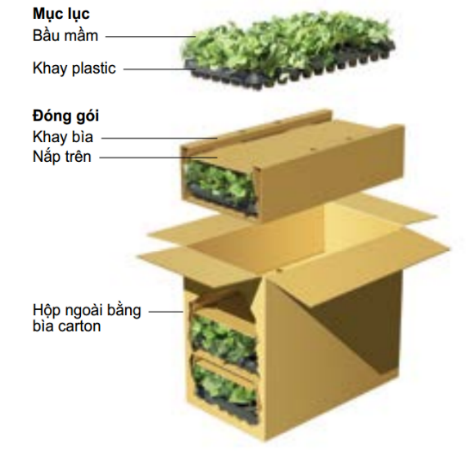 |
| Plants | A. When transporting plants, it is important to secure them to prevent movement inside the shipping box. B. If placing the plants inside a cardboard box, the stems and leaves may get damaged, so it is recommended to use cardboard dividers to secure the pots inside the box. C. The soil inside the box should also be packaged. Place the pot in a plastic bag and tie the bag around the base of the plant. D. If the plant has multiple stems, you can insert paper between the leaves and place it on top of the soil to keep the plant secure in the pot. | 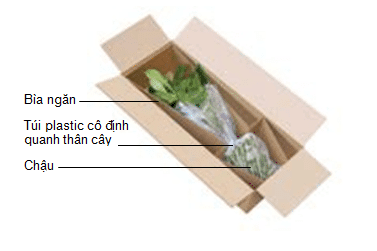 |
| Orchids | A. Orchids require special packaging as they are prone to falling off easily. B. When transporting potted orchids, secure the pot in a carton box using string or twine, leaving enough space between the orchids to keep them separate during transit. C. The contact between flowers and leaves can cause damage to the orchid blooms. You can use paper to wrap the flowers and leaves to provide an additional cushioning layer during transportation. D. Low temperatures can affect tropical flowers such as orchids. Therefore, when shipping to colder regions, ensure that the packaging is designed to protect the flowers from temperature fluctuations during transit. | 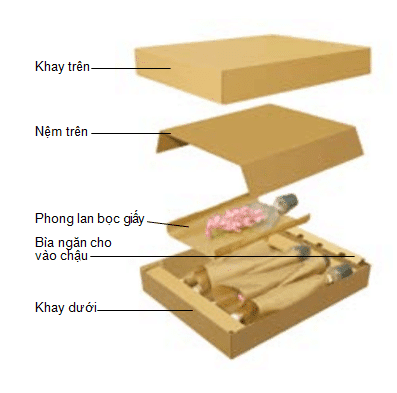 |
| Household Appliances | A. Insert additional 6-sided foam products with a minimum thickness of 5cm around before putting in the container. B. In the case of large-sized household appliances, it is recommended to insert foam with a thickness of 5 cm or more around the product before packing it into the shipping box. It is advisable to use a 3-layer carton box and seal the folds of the box with tape to ensure safety during transportation, for example, induction hobs, rice cookers. C. The carton box should be made of 3-layer cardboard to ensure safety during transportation. D. The joints and folds need to be thoroughly sealed with tape. | 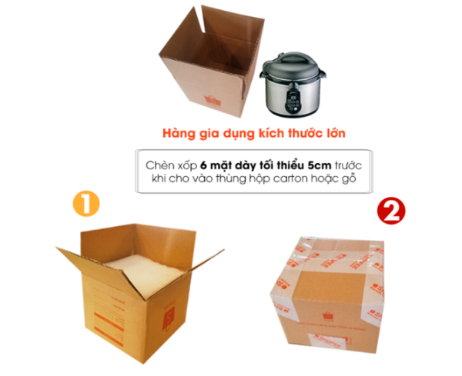 |
| Goods in long cylindrical shapes: paintings, maps, fishing rods, light bulbs. | A. Place the rolled product into a plastic tube (not too large for the product) and do not use connected plastic tubes to contain the product. B. Seal and secure both ends with tape. C. Use shock-resistant materials (bubble wrap, etc.), wrap the plastic tube in 3-4 layers, and reinforce the package with tape. D. Label the outside of the box with a "Fragile" warning. | |
| Liquids contained in jerry cans, bags, bottles, etc. with a volume greater than 1 liter (laundry detergent, fabric softener, etc.) | A. Securely tape the lid and wrap the product tightly with bubble wrap to ensure the liquid does not leak (even if inverted). B. The product must be sealed in a plastic bag and tightly secured with tape. Then, wrap the product in 4 layers of bubble wrap and reinforce it with tape. C. Place the product in a cardboard box and use soft foam to secure it so there are no empty spaces inside the box. D. If placing multiple products in one box, they must be separated by dividers or cushioned with elastic materials such as foam to prevent movement. E. Label the outside of the box with a "Fragile" warning. | |
| Dry food (nuts, fruits, seafood, meat, etc.) | A. Dry food items need to be packed in multiple layers of plastic or bubble wrap (2 to 3 layers) and secured with tape to be airtight, moisture-proof, and shock-resistant (for easily breakable foods), and vacuum-sealed to preserve food quality. B. Wrap thoroughly to prevent odors that might attract animals/insects before placing them in a sturdy carton box. C. Pay attention to the storage conditions of the food (light, temperature, humidity) as well as the expiration date to avoid spoilage during transportation. D. Do not accept products with a short shelf life (less than 6 months) for transportation. |
2. Regulations on Goods and Billable weight
REGULATIONS ON GOODS:
- Maximum order and collection value (COD): VND 20,000,000 (Twenty million Vietnam dong).
- Maximum weight of the order: 50 kg.
- Maximum dimension of order: 80x80x80 (cm)
REGULATIONS ON BILLABLE WEIGHT (Effective date: starting Sep 1, 2023)
Billable weight = Greater of Shipper weight, Shipper dim weight, NJV weight, NJV dim weight (kg)
Note:
+ Shipper weight (kg): gross weight submitted by the Shipper on the mobile app/ dashboard
+ Shipper dim weight (kg): weighted converted from parcel’s dimensions inputted by the Shipper on the mobile app/ dashboard
+ NJV gross weight (kg): gross weight by Ninja Van
+ NJV dim weight: weight converted from the parcel’s dimensions measured by Ninja Van
Formula to convert gross weight to dim weight:
Dim weight (kg) = Length (cm) x Width (cm) x Height (cm)/ 6000
(Certificate of scale verification here)
3. Prohibited goods
The following items are prohibited from being shipped or transported through our services:
- Financial instruments: Credit cards, debit cards, prepaid cards, ATM cards, and other types of bank cards;
- Human or animal remains, religious artifacts;
- Weapons, support tools, explosives, explosive precursors;
- Live animals;
- Perishable goods such as vegetables and fruits;
- Toxic substances, hazardous chemicals, radioactive materials, disease-causing microorganisms;
- Original inspection certificates, passports, and insurance documents;
- Original written documents, original films, tapes, and film materials;
- Tobacco, other tobacco products, tobacco leaves, raw materials, and accessories (including e-cigarettes, heated tobacco products, gases, addictive substances, and substances harmful to human health);
- Flammable, ignitable, or volatile items such as firecrackers, firecracker powder, batteries, kerosene, gas cylinders, or paint solvents;
- Cash, checks, invoices, stocks, and other valuable papers;
- Precious metals (gold, silver, platinum, etc.), precious stones, or other products made from precious metals or stones;
- Narcotics, precursors, plants containing narcotics, including medical cannabis;
- Pornographic materials, items contrary to social ethics or Vietnamese customs and traditions, or items with content that incites, causes insecurity, undermines national unity, or opposes the state;
- Items and goods prohibited by Vietnamese law from circulation, import, export, or postal transportation as stipulated by Vietnamese law, international treaties to which the Socialist Republic of Vietnam is a party, or items that Ninja deems insufficient to meet the necessary conditions for Ninja to transport, for shippers to trade, or for items and goods to circulate in accordance with the law.


